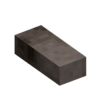Żelazo
| Żelazo | |

| |
| Stackable | 16 |
| Smeltable | |
| Smelt Point | 1482°C |
| Requires Container | Yes |
| Output | Forma do odlewania metalu |
| Output Amount | 1 |
| Items | |
Żelazo jest metalem czwartego poziomu. Żelazo może być rafinowane przez skomplikowany proces z jego rud, czyli hematytu, magnetytu lub limonitu. Żelazo może być przekute w różnorodne narzędzia, bronie, pancerze i przedmioty. Jest komponentem do produkcji stali, czyli najwyższego poziomu metalu w grze.
Pozyskiwanie
Z powodu jego wysokiej temperatury topnienia, rudy żelaza nie mogą być przetopione w tyglu jak brąz czy miedź. Zamiast tego, bryłki rudy żelaza (w formie bryłek hematytu, limonitu lub magnetytu) muszą być przetapiane w dymarce aby otrzymać łupkę żelaza, która może być następnie oczyszczona na kowadle z brązu lub lepszym w sztabkę żelaza, która może być następnie przekuta w narzędzia.
Rudy
W grze występują trzy rodzaje rud zawierających żelazo: hematyt, magnetyt i limonit. Mogą one występować w różnych warstwach skalnych na różnych głębokościach, ale wszystkie są tak samo zdolne do produkcji żelaza. 20 bryłek tych rud daje jedną łupkę żelaza. Kilof co najmniej trzeciego poziomu (brąz) jest potrzebny w celu wydobycia tych rud.
Hematite can be found in large, deep underground deposits in limestone, granite, peridotite, and phyllite. Magnetite can be found in andesite, chalk, conglomerate, claystone, and slate. Limonite can be found in chert, shale, and basalt. Taken as a whole, this means iron ores can generate in any rock layer except for sandstone and bauxite.
Dymarka
- See also Bloomery.
In order to turn iron ore nuggets into iron blooms, the ore nuggets must be smelted in a bloomery, created from fire clay bricks. The bloomery must be loaded with the ore, then with an appropriate fuel - either charcoal, black coal or anthracite coal. The bloomery will burn for around 10 hours, after which it may be broken open to retrieve the iron blooms. Bloomeries are destroyed after a single use, so a new one must be made each time the player wants to turn iron ore nuggets into iron blooms.
Wrought iron
Iron blooms must be further worked on an anvil while hot to turn it into usable wrought iron ingots. This may be done manually, with a hammer and a bronze or better anvil, or be automated with a helve hammer. Cold iron blooms can be reheated in a forge.
Manual processing is done by placing a hot iron bloom on the anvil. Using a hammer, remove all the dark slag spots and manipulate the hot iron into the shape of an ingot. With a helve hammer setup, the bloom just needs to be placed on the anvil under the hammer, and it will slowly be turned into wrought iron. Each hit of the helve hammer removes a single voxel, so processing speed is dependent on the specific setup of the machine.
Usage
Iron cannot be used for casting, and must be smithed on an anvil to produce useful items. Notably, iron anvils must also be smithed on a bronze or better anvil. This process involves creating a separate top and bottom half, then welding the two together using crushed borax.
Iron can be used to create a wide variety of tools, weapons, armor, and other useful items.
Alloys
- See also Steel.
The only alloy of iron currently in the game is steel, which is an alloy of iron and carbon. Steel is the highest tier metal in the game, but requires a complex process to create.
Progression
Acquiring iron tools and the means to produce iron is referred to as entering the "Iron Age". Iron has several advantages over bronze in item durability and efficiency, but also the availability of iron ore as compared to the metals needed to create bronze. On the other hand, iron is harder to work with as it cannot be cast, only smithed. Additionally, iron ingots require a more complicated process to make, and requires players to find a good source of fire clay as well as produce large quantities of high-temperature fuel.
| Ores, metals and minerals | |
|---|---|
| Guides | Ore Deposits • Metals |
| Metals | Copper • Iron • Meteoric iron • Gold • Silver • Lead • Tin • Zinc • Bismuth • Titanium (Ilmenite) • Nickel |
| Alloys | Bronze (Tin bronze, bismuth bronze, black bronze) • Steel • Brass • Solder (Lead solder, Silver solder) • Molybdochalkos • Cupronickel • Electrum |
| Minerals | Alum • Borax • Cinnabar • Coal • Halite (Salt) • Lapis lazuli • Quartz • Saltpeter • Sulfur • Sylvite (Potash) |
| Tools | Pickaxe • Hammer • Prospecting Pick • Crucible • Forge • Ore blasting bomb • Quern • Anvil • Bloomery • Helve hammer • Pulverizer |
| Other | Gemstones |
| Related mechanics | Panning • Mining • Clay forming • Casting • Smithing • Steel making |
| Wiki Navigation | |
|---|---|
| Vintage Story | Guides • Frequently Asked Questions • Soundtrack • Versions • Controls |
| Game systems | Crafting • Knapping • Clay forming • Smithing • Cooking • Temperature • Hunger • Mining • Temporal stability • Mechanical power • Trading • Farming • Animal husbandry |
| World | World generation • Biomes • Weather • Temporal storms |
| Items | Tools • Weapons • Armor • Clothing • Bags • Materials • Food |
| Blocks | Terrain • Plants • Decorative • Lighting • Functional • Ore |
| Entities | Hostile entities • Animals • NPCs • Players |
| Miscellaneous | List of client commands • List of server commands • Creative Starter Guide • Bot System • WorldEdit • Cinematic Camera • Adjustable FPS Video Recording • ServerBlockTicking |